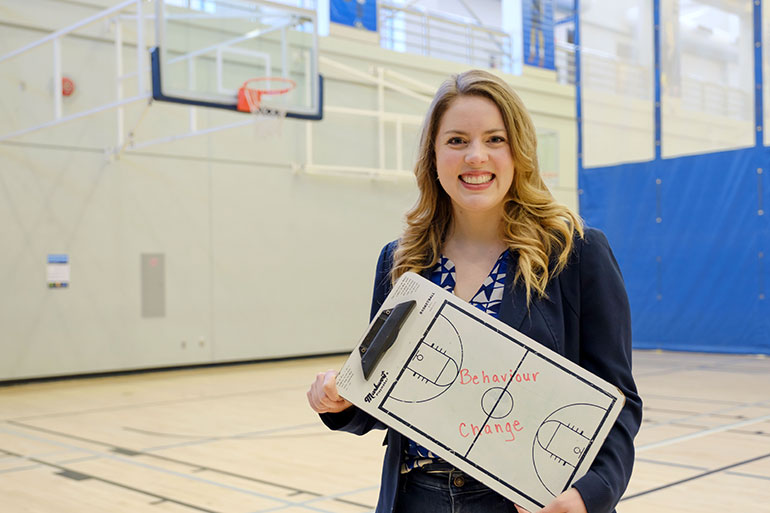
Assistant Professor Heather Gainforth researches behaviour change with the School of Health and Exercise Sciences.
Videos help analyze what works to help people change their behaviours
Using a page from a coach’s playbook, a UBC researcher has come up with a method to analyze behaviour change counselling sessions and determine what makes them work.
UBC Okanagan Assistant Professor Heather Gainforth researches behaviour change with the School of Health and Exercise Sciences. She has recently published research explaining her approach to understanding the play-by-play of counselling sessions to help people make positive changes in their lives.
It’s common for sports psychologists to use audio and video recordings of practices to analyze and closely examine the relationship between a coach and a player, she explains. They study every word, every move and every reaction to determine how the coach supports the athlete to have a positive or negative experience during training.
“I realized when I was working with sports psychologists that they are studying every single interaction of the coaches and the athletes,” says Gainforth.
It’s an idea she wanted to try in her own field of expertise.
“When a person goes for behaviour change counselling it either works or it doesn’t,” she says. “But we couldn’t actually determine exactly why. What makes it work? Why did it fail? And I kept thinking, how can we figure out what makes these interventions work?”
While working with clients hoping to quit smoking, Gainforth tried the video play-by-play analysis. With permission, she used audio and video recordings to scrutinize minuscule details of sessions between a client and counsellor.
By examining behaviour change counselling second-by-second, she looked at the frequency, sequence and duration of each interaction between a client and a counsellor. Behaviour change happens, she explains, during a conversion between a client and a practitioner.
“I wanted to know what happens in that conversation,” she adds. “I wanted a second-by-second analysis of these interactions to understand what works to help clients change their behaviour.”
Gainforth developed a method to analyze these videotaped sessions verbatim.
She then used state-space grids to map each interaction in real time and monitor how the practitioner and the client interact together. Gainforth says the grids allow researchers to examine the dynamics between the client and the practitioner. It’s the first time in behavioural science, she adds, that researchers have been able to understand how these interactions actually make a difference.
“We have created a new method for people working in behavioural science,” she says. “By coding the interactions second-by-second, we’ve created a method to visualize the counselling sessions over time. We can map everything the practitioner says and how the client reacts and then we examine how they interact with each other over time.”
Gainforth’s research, partially funded through the Michael Smith Foundation for Health Research, was published in the British Journal of Health Psychology.
About UBC’s Okanagan campus
UBC’s Okanagan campus is an innovative hub for research and learning in the heart of British Columbia’s stunning Okanagan Valley. Ranked among the top 20 public universities in the world, UBC is home to bold thinking and discoveries that make a difference. Established in 2005, the Okanagan campus combines a globally recognized UBC education with a tight-knit and entrepreneurial community that welcomes students and faculty from around the world.
To find out more, visit: ok.ubc.ca.